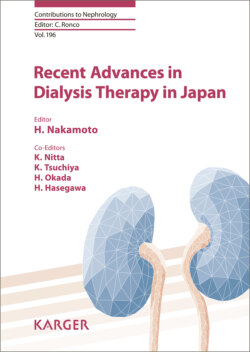Читать книгу Recent Advances in Dialysis Therapy in Japan - Группа авторов - Страница 67
На сайте Литреса книга снята с продажи.
Anemia and Cognitive Impairment
ОглавлениеDespite the lack of clinically apparent neurological symptoms or morphological abnormalities, patients with CKD accompanied by anemia present with impairment in cerebral blood flow (CBF) and oxygen metabolism, which is reportedly prominent in the frontal cortex [6–8]. Meanwhile, renal anemia correction with recombinant human erythropoietin (rHuEPO) has been shown to improve brain function. Using the Wechsler Adult Intelligence Scale, Temple et al. [9] reported that brain function was improved as anemia was corrected with rHuEPO therapy (hemoglobin, 5.8 → 9.3 g/dL). Grimm et al. [10] measured event-related EEG potentials (P300) of the brain in 15 patients undergoing chronic hemodialysis and found that anemia correction with rHuEPO therapy (hematocrit, 22.7 → 30.6%) significantly decreased P300 peak latency and improved higher brain function (Fig. 4). P300 is considered to be potentially associated with intellectual information processing, such as stimulus perception, discrimination, and task execution, whereas its peak latency is an indicator of stimulus evaluation time in intracerebral information processing. P300 latency is reportedly prolonged with aging and neurological diseases, and it is also known to be markedly prolonged particularly in patients with dementia. In addition, P300 latency has been shown to correlate with scores of general intellectual functioning tests, such as Mini-Mental State Examination and revised Hasegawa Dementia Scale, and with CBF. Moreover, although P300 latency is prolonged in some individuals without neurological abnormalities but with almost normal intellectual function, P300 latency may be used to detect early-stage dementia or latent cognitive impairment.
We used positron emission tomography to examine regional cerebral blood flow (rCBF) and regional cerebral metabolic rate of oxygen (rCMRO2) in patients undergoing chronic hemodialysis [6]. In patients with severe anemia with a hematocrit level of 21%, the mean rCBF in the cerebral cortex was 40 mL/100 g/min, which was 24% higher than the mean rCBF of 32 mL/100 g/min in the control group. However, the patients’ mean rCMRO2 was 1.48 mL/100 g/min, which was 32% lower than the mean rCMRO2 of 2.18 mL/100 g/min in the control group. The patients’ mean regional oxygen extraction fraction (rOEF) was 49%. This value was higher than the mean rOEF of 38% in the control group, but this indicates that rOEF was not sufficiently compensated for in the patients. In the gray matter, the frontal cortex showed lower values of both rCBF (38.7 mL/100 g/min) and rCMRO2 (1.47 mL/100 g/min) than the other regions. In other words, when anemia is severe in patients undergoing hemodialysis, rCBF and rOEF are high; however, rCMRO2 is low (luxury perfusion). This trend is prominent in the frontal cortex.
Furthermore, in the cerebral gray matter, a significantly inverse correlation was observed between hematocrit levels and rCBF [6]. When rCBF at a hematocrit level of 40% was estimated by substituting the hematocrit level in the control group (40%) into the regression line, the estimated value was lower than the actual measurement in the control group by approximately 20%. This phenomenon suggests that CBF in patients undergoing chronic hemodialysis with the same hematocrit level is lower than that in the control group and is not sufficiently compensated for or increased in an anemic state. However, our analysis was based on measurements taken in the early stages when hematocrit levels reached 30%; thus, further investigation may need to be conducted in patients with long-term improvement in anemia. In addition to the abnormalities in the mechanism for suppressing CBF, brain metabolism was low, which suggested that a low demand for CBF might suppress CBF to a low level. When the hematocrit level increased from 21 to 31% after anemia correction by rHuEPO therapy, rCBF and rOEF significantly decreased from 40 to 32 mL/100 g/min and from 49 to 42%, respectively. These levels became comparable to those in the control group. It was considered that rCMRO2 would probably significantly increase, because the arterial oxygen content (CaO2) also significantly increased. However, rCMRO2 in the cerebral hemispheres only slightly increased to 1.58 mL/100 g/min, and the increase was not significant. In contrast, rCMRO2 in the frontal cortex slightly but significantly increased from 1.48 to 1.60 mL/100 g/min. Next, we estimated an optimal hematocrit for the maximum oxygen delivery to the brain with rHuEPO [11]. We observed a significant increase in CaO2 from 7.7 to 11.6 mL O2/100 mL blood (p < 0.01). Hemispheric rCBF decreased significantly from 40 to 32 mL/100 g/min (p < 0.02). In all data both before and after rHuEPO treatment, hematocrit inversely correlated with the hemispheric rCBF, and positively with CaO2. By using these correlations, the hemispheric oxygen delivery was expressed as a function of hematocrit, being y = 47.34 + 18.29 x – 0.26 x2, where y is cerebral oxygen delivery and x is hematocrit. From this curve, hematocrit at the highest cerebral oxygen delivery in the hemisphere, i.e. an optimal hematocrit was found to be 35.2% (Fig. 5) [11].
According to these reports, in patients with CKD accompanied by severe anemia, anemia correction can probably improve cognitive function. However, whether cognitive function is improved by normalizing hemoglobin levels (to ≥13 g/dL) in patients with mild anemia (hemoglobin, 10–12 g/dL) is unknown. Given the concerns for the increased risk of stroke, it is better to refrain from setting a target hemoglobin level at 13 g/dL or higher.
Fig. 5. The regional cerebral oxygen delivery to the hemisphere. The regional cerebral oxygen delivery to the hemisphere was expressed as a function of hematocrit, y = 47.34 + 18.29 x − 0.26 x2, where y is arterial oxygen content and x is maximum level at a hematocrit of 35.2%. Open circles (before recombinant human erythropoietin, rHuEPO) and closed circles (after rHuEPO) are the values calculated from the actual data. Reproduced from [11].
